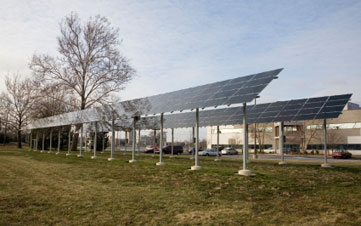
Even as the national economy struggles, some regions anticipate future prosperity. Though unlikely to surpass powerhouses of the U.S. economy such as California’s Silicon Valley, Boston’s Route 128 corridor and North Carolina’s Research Triangle, they may well give better-known up-and-comers such as Austin, Tex., Charlotte, N.C., and Denver, Colo. a run for the money.
Consider these five examples of how areas are leveraging their strengths for future growth and betting on industries that are poised for takeoff.

North Dakota's Oilpatch Boom
Energy is North Dakota’s ticket to success. High oil prices and the development of technologies to unlock previously unreachable oil and gas reserves are rocketing the Peace Garden State to the fastest pace of gross domestic product growth and the lowest unemployment rate in the nation. About 26,000 new oil wells are in the blueprint for the next 25 years. That’ll fuel five to seven years of very swift growth and sustain the state’s economy for two decades. What’s more, even if oil prices drop by 50%, low exploration costs and proven supplies will keep the state producing.
To help keep growth on track, North Dakota has a fairly hands-off regulatory attitude, and state policymakers are mulling ways to simplify taxes on the state’s oil industry.

Portland, Ore.: Hip, Smart, Green
Rose City is betting on its appeal to a young creative class of workers to build a 21st-century clean economy. Portland expects its workforce to grow by 2.4% a year over the next decade—six times as fast as the U.S. average rate. What’s more, the number of 25- to 34-year-olds there grew 12% from 1990 to 2000. Across the U.S., that age group shrank 8%. A third of Portland’s young adults have college degrees.
The city already has a strong technology bent. It’s home to large operations for Intel and Hewlett-Packard, 40-odd solar power firms and two big wind energy firms. Oregon is also nurturing more clean tech—green construction, ocean energy and nanotechnology. The Oregon Nanoscience and Microtechnologies Institute has helped 22 nanotech start-ups raise $96 million. The Oregon Wave Energy Trust aims to make the state a clean energy leader, eventually generating 500 megawatts of electricity and thousands of jobs with technology to harness the oceans’ wave power.

Maryland: Bioscience Central
Maryland is investing in bioscience research and development. Nurtured by a slew of laboratories within its borders, including those for the U.S. Departments of Agriculture, Commerce, Defense and Homeland Security, the National Institutes of Health and Johns Hopkins University, the state enjoys a 44% greater concentration of bioscience talent than the national average.
Under Gov. Martin O'Malley's BioMaryland 2020 strategy, the state plans to bolster the sector with more private investment and increased commercialization of basic R&D work. It’s sinking $1.3 billion into programs over 10 years. Notably, even in these tight times, Maryland is forging ahead, raising its biotech tax credit and approving the InvestMaryland plan, which provides tax credits to insurance companies for investing in the Maryland Venture Fund.

Minneapolis-St. Paul: Exporting Technology
Export know-how and medical technology are the edge for the Twin Cities. Despite a reputation as being unfriendly to business, the region has a lot going for it: An educated workforce (nearly 38% have a college degree). A patent rate that’s double that of the U.S. as a whole. And 21 Fortune 500 firms that call the region home. Among the area’s business initiatives is the Entrepreneurship Accelerator. Funded by nonprofits and local government, the multimillion-dollar, 10-year project is committed to financing about 50 start-ups.
Working with the Brookings Institution, metro planners are also crafting an export strategy to capitalize on the area's strong base of medical device companies and industry collaboration with the Mayo Clinic. As ever more miniature devices to deliver therapies via cells are developed, the area is well positioned to grow from its current rank as 15th-largest exporter among cities.

Ohio's Manufacturing Revival
Ohio is hitching its wagon to advanced manufacturing. The Buckeye State aims to retool its ailing old-school industries to produce 21st-century technologies, replicating in a variety of venues the transition that Toledo glassmaker Pilkington North America made to photovoltaic materials. One of Ohio’s long-term bets: Flexible electronics—circuits imprinted on polymer films—parlaying expertise developed at Kent State University.
To help with the transition and boost job creation, Gov. John Kasich (R) has recruited a Silicon Valley venture capitalist to head JobsOhio, a nonprofit group run by government appointees and financed by the lease of Ohio’s liquor franchise.

More from Kiplinger
SLIDE SHOW: 11 Comeback Cities for 2011
SLIDE SHOW: 8 Emerging U.S. Gateways for Immigrants
Profit and prosper with the best of Kiplinger's advice on investing, taxes, retirement, personal finance and much more. Delivered daily. Enter your email in the box and click Sign Me Up.
-
 Forget FIRE: Why ‘FILE’ Is the Smarter Move for Child-Free DINKs
Forget FIRE: Why ‘FILE’ Is the Smarter Move for Child-Free DINKsHow shifting from "Retiring Early" to "Living Early" allows child-free adults to enjoy their wealth while they’re still young enough to use it.
-
 7 Tax Blunders to Avoid in Your First Year of Retirement
7 Tax Blunders to Avoid in Your First Year of RetirementA business-as-usual approach to taxes in the first year of retirement can lead to silly trip-ups that erode your nest egg. Here are seven common goofs to avoid.
-
 How to Plan for Social Security in 2026's Changing Landscape
How to Plan for Social Security in 2026's Changing LandscapeNot understanding how the upcoming changes in 2026 might affect you could put your financial security in retirement at risk. This is what you need to know.
-
 What to Expect from the Global Economy in 2026
What to Expect from the Global Economy in 2026The Kiplinger Letter Economic growth across the globe will be highly uneven, with some major economies accelerating while others hit the brakes.
-
 Amid Mounting Uncertainty: Five Forecasts About AI
Amid Mounting Uncertainty: Five Forecasts About AIThe Kiplinger Letter With the risk of overspending on AI data centers hotly debated, here are some forecasts about AI that we can make with some confidence.
-
 Worried About an AI Bubble? Here’s What You Need to Know
Worried About an AI Bubble? Here’s What You Need to KnowThe Kiplinger Letter Though AI is a transformative technology, it’s worth paying attention to the rising economic and financial risks. Here’s some guidance to navigate AI’s future.
-
 Will AI Videos Disrupt Social Media?
Will AI Videos Disrupt Social Media?The Kiplinger Letter With the introduction of OpenAI’s new AI social media app, Sora, the internet is about to be flooded with startling AI-generated videos.
-
 What Services Are Open During the Government Shutdown?
What Services Are Open During the Government Shutdown?The Kiplinger Letter As the shutdown drags on, many basic federal services will increasingly be affected.
-
 The Economy on a Knife's Edge
The Economy on a Knife's EdgeThe Letter GDP is growing, but employers have all but stopped hiring as they watch how the trade war plays out.
-
 Apple Readies for AI Upgrade with New iPhones
Apple Readies for AI Upgrade with New iPhonesThe Kiplinger Letter The tech giant has stumbled when it comes to artificial intelligence, but a new batch of iPhones will help it make headway.
-
 Japan Enters a New Era of Risk and Reform
Japan Enters a New Era of Risk and ReformThe Kiplinger Letter Japan has entered a pivotal moment in its economic history, undertaking ambitious policy and structural reforms to escape from decades of stagnation.
